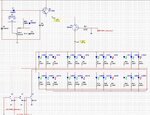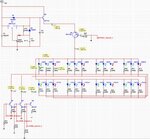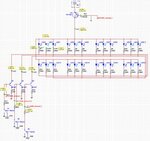KlausST
Advanced Member level 7

Hi,
It´s not a problem of the TLC4950, it´s a problem of your circuit that it can´t shut down the LEDs completely.
--> The TLC4950 is designed to properly work with up to 17V LED voltage. And it can drive up to 120mA. Enough to supply 8 LEDs with 15mA each.
You overcomplicate the circuit. Causing much trouble.
Calculate the reisitors for 15mA at 3,9V (across LED and resistor). Supply the whole circuit with 5V and you are done.
No need for 12V, no need for an extra voltage regulation circuit, no need for extra BJTs, reduced heat. Where is a drawback?
This causes about 2W per IC of power dissipation. Thus I recommend a proper thermal PCB layout and additionally I´d glue a heatsink onto each driver IC.
Klaus
And I have experimented with TLC4950 on my bread board. If you apply 12V to a single led attached to one of the channels then the TLC4590 can't completely shut off the LED. It's logic circuit runs of 5V and can only apply 5V to the channels. Same principal as trying to turn off a PNP transistor with the voltage applied to the base less that the voltage applied to the emitter.
It´s not a problem of the TLC4950, it´s a problem of your circuit that it can´t shut down the LEDs completely.
--> The TLC4950 is designed to properly work with up to 17V LED voltage. And it can drive up to 120mA. Enough to supply 8 LEDs with 15mA each.
You overcomplicate the circuit. Causing much trouble.
Calculate the reisitors for 15mA at 3,9V (across LED and resistor). Supply the whole circuit with 5V and you are done.
No need for 12V, no need for an extra voltage regulation circuit, no need for extra BJTs, reduced heat. Where is a drawback?
This causes about 2W per IC of power dissipation. Thus I recommend a proper thermal PCB layout and additionally I´d glue a heatsink onto each driver IC.
Klaus




